Guest Post by Huan Lee, Lambient Technologies
The ion viscosity of a thermoset is the frequency independent resistivity (rDC). In many cases ion viscosity is proportional to mechanical viscosity before gelation and proportional to modulus after gelation, making ion viscosity a useful probe of material state through the entire cure.
Figure 1 shows the behavior of a typical thermoset with one temperature ramp step and one temperature hold step.
Figure 1. Typical Ion Viscosity behavior of a curing thermoset
Four Critical Points characterize the dielectric cure curve:
- CP(1)—A user defined level of ion viscosity, typically used to identify the onset of material flow.
- CP(2)—Ion viscosity minimum, which closely corresponds to the mechanical viscosity minimum.
- CP(3)—Inflection point, when the reaction begins to slow, can be associated with gelation but does not indicate gelation.
- CP(4)—A user defined slope to define the end of cure.
Dielectric/Conductivity Sensors
Dielectric instrumentation measures the resistance (R) and capacitance (C) between a pair of electrodes at a given frequency. The Material Under Test (MUT) between a pair of electrodes can be modeled as a resistance in parallel with a capacitance, as shown in Figure 2.
Figure 2. Electrical Model of dielectric Material Under Test (MUT)
Simple parallel plate electrodes, shown in Figure 3, can measure the dielectric properties of material between the electrodes. The ratio of electrode area A and the distance D between them—the A/D ratio—is a figure of merit. A larger A/D ratio corresponds to greater sensor sensitivity. The A/D ratio is also the scaling factor for calculating resistivity from resistance, and permittivity from capacitance. Unfortunately, distance D can change with pressure, or with expansion and contraction of the material, causing inaccurate results.
An alternative is the interdigitated electrode, also shown in Figure 3. A rigid substrate supports the electrodes and resulting the planar structure does not change with pressure, or expansion and contraction of the MUT. While the parallel plate sensor makes a bulk measurement, an interdigitated sensor makes a surface measurement. As a rule of thumb, interdigitated electrodes with the same width and separation “see” into material to a depth approximately equal to the electrode width. The parameter of A/D ratio also applies to interdigitated electrodes as a figure of merit and is the scaling factor for calculating resistivity and permittivity.
Figure 3. Comparison of parallel plate and interdigitated electrodes
Figure 4 shows a typical disposable dielectric/conductivity sensor with interdigitated electrodes 100 microns wide. Constructed as a Kapton® flex circuit, this sensor is thin enough to be inserted between the plys of a laminate and may be discarded after use. The narrow electrodes, too small to be visible in the figure, result in a large A/D = 160, with correspondingly great sensitivity. The trade-off is the measurement of dielectric properties only within 100 microns of the surface.
Figure 4. Disposable dielectric/conductivity sensor on polyimide flex circuit
Figure 5 shows a reusable dielectric/conductivity sensor embedded in a platen for a small press. This sensor is constructed with interdigitated electrodes embedded in ceramic and has an A/D = 10. When mounted as shown, it is possible to place a sample in the press, then heat and compress it and simultaneously make dielectric measurements to monitor cure. Afterward the sample can be removed from the sensor and the process can be repeated.
Reusable sensors are convenient for applications such as Quality Assurance/Quality Control (QA/QC), which involve repetitive testing. Note the wider electrodes, visible in Figure 5. This sensor is able to measure more deeply into the material, with the trade off of decreased sensitivity because of the smaller A/D ratio.
Figure 5. Reusable dielectric/conductivity sensor embedded in press platen
Dielectric/conductivity sensors have two general configurations, parallel plate or interdigitated electrodes. The selection of a sensor depends on the desired type of measurement, either surface or bulk, and the desired sensitivity as indicated by the A/D ratio.
Lambient Technologies
209 Newbury Street, 3rd Floor
Boston, MA 02116
617-266-2837
email: info@lambient.com

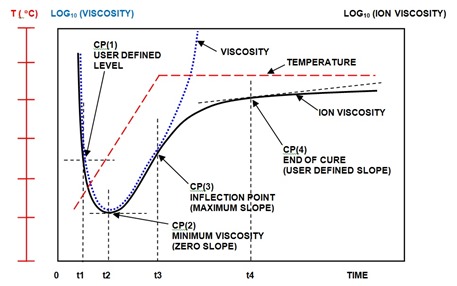
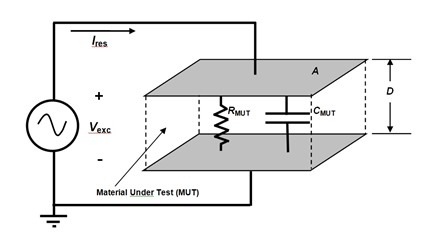
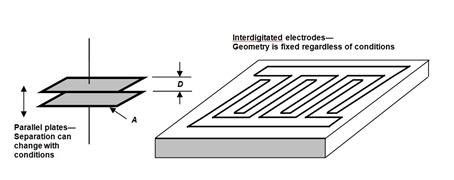
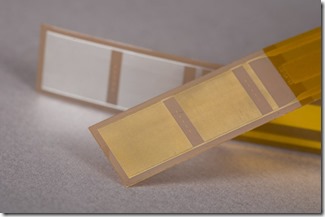
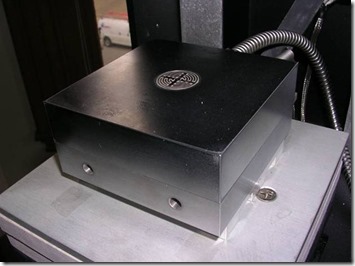

Leave a Reply